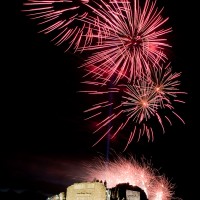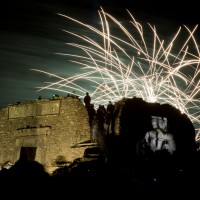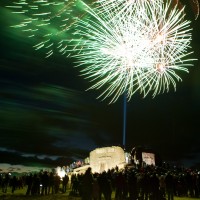How to take great photographs of firework displays
Taking great fireworks photos is easy, and can be done with most cameras with a few manual controls. You need to get a few things right before the fireworks start:
1. Be prepared
Before the event, fully charge your camera’s batteries and if possible carry a second battery in your pocket, near to your body heat. Cold batteries (in cold weather) lose their charge very quickly, so rotate the batteries to keep them warm if it’s very cold. Clear out your memory card and carry a spare. A torch or head torch is a great thing to pack in your bag. Take a drink with you so you don’t need to queue up for drinks and miss the fireworks!
2. Manage your photoshoot time
If you are with family or friends, it’s best to let them know in advance you will be ‘working’ – moving about and not free to chat/socialise. Free up your time and ensure people know not to expect anything from you.
3. Scout the event location
Straight away when you arrive, leave your camera in the bag and have a look around the site for the most dramatic vantage points. Including crowds, trees, buildings or reflections can add drama and context to your firework shots. Big fires can be too bright in the shots, but experiment. Be far enough away from the fireworks to get the sky rockets display in shot, and not cropped in half.
4. Use a tripod
This does not need to be a posh or heavy tripod for this type of work, but you will need one if you want to get great results with longer exposures. Set the tripod up with plenty of room around you, as soon as you can into the evening.
5. Use portrait format
For displays that feature sky-rocket fireworks, working in portrait format (the camera turned on its side on the tripod), means you to get the whole scene in the shot, from the ground to the burst point in the sky for rockets, again creating context.
6. Set the camera up in advance
You are looking for longer exposures here, this will allow the whole of a firework ‘burn-time’ to render on your sensor, creating dreamy colour trails on your images. You want to be in manual mode. If you don’t usually work in manual mode, check you know how to change the shutter speed and aperture before the event (i.e. when it’s warm, dry and you can see!). For manual shooting start with your settings at a 5 second exposure at F.5.6 aperture is a good place to start. ISO can stay low to help capture the best dynamic range – around ISO 100 to 200. The wide angle end of a lens is often best these shots.
7. Work quickly
Once the fireworks start you don’t have long before they are over, so work quickly and monitor your cameras settings as you start to see the results on your camera’s LCD screen. If required, adjust the shutter speed up or down to make the shots brighter or darker. Stay within the 1-10 second shutter speed range though. You are looking for good bright colours without too many ‘blown-out’ white areas (fireworks that show on your LCD as the larger areas of pure white contain no information and might be over-exposed).
8. Move around
Once you have some great shots from one location, change your angles – you can adjust the lenses focal length, the tripod height and of course your location. Imagine yourself documenting the event for a newspaper – this will force you to be creative, keep moving and keep shooting where others will have stayed still or gone for a drink!
9. Post-process the images for great results.
As soon after the event as possible, get the images onto your computer. Delete what hasn’t worked straight away. If you have the software, using RAW format is best for retaining the most file resolution and colour. Increase the saturation, contrast and sometimes the blacks for high-impact shots. Check the colour balance is realistic, if your software lets you.
10. Publish quickly and widely!
There is no point in taking amazing shots if you leave them on your computer. Send copies to your friends/family, publish them of Flickr or Facebook, but better, if you have local community newsletters, local papers, school website forums, council community updates, local web blogs, etc, get in touch with them. If you follow all the previous nine tips, your pictures should be better than most of the other photographers at the event and you could get published! It feels great to see your images being used, and gives a little back to the local community.




[…] via How to photograph fireworks | David White Studio. […]